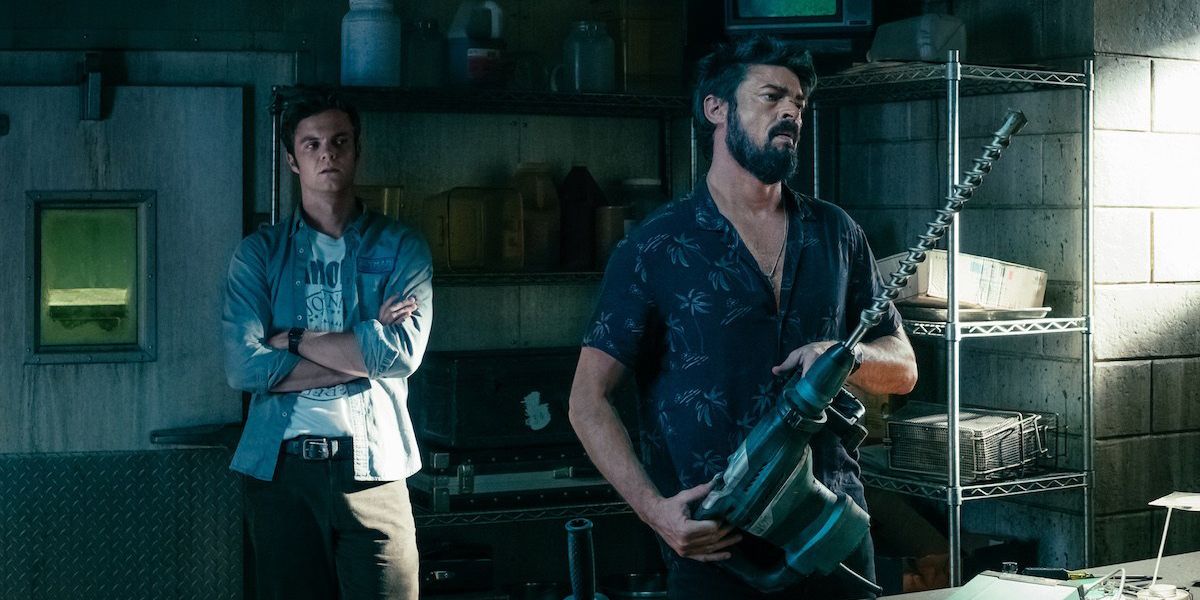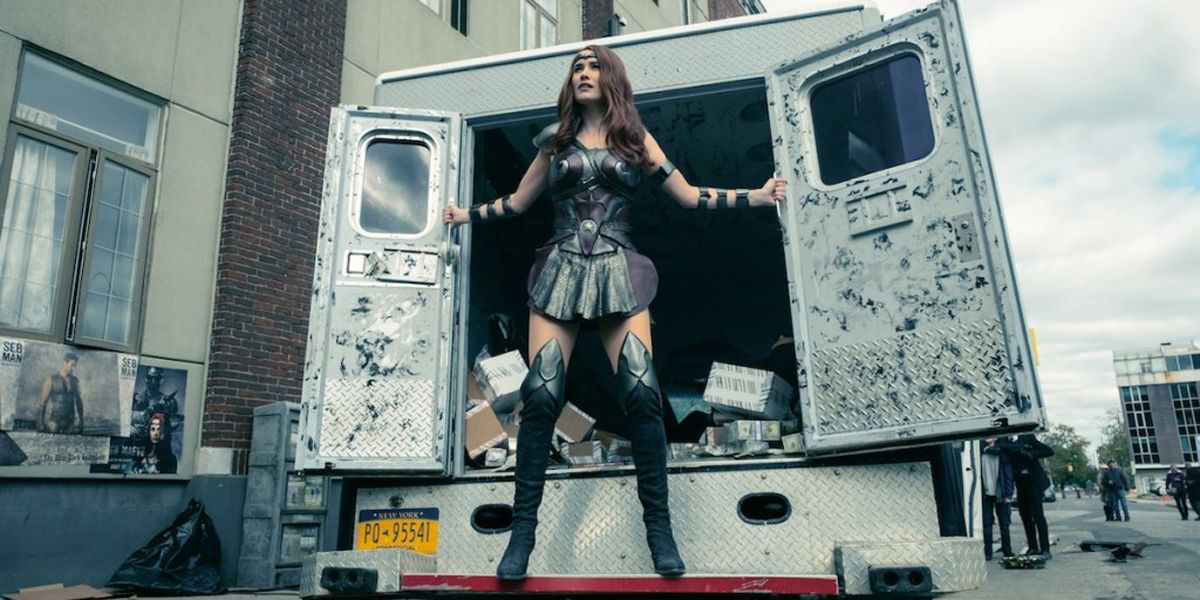WARNING: The following article contains mild spoilers for Season 1 of The Boys, streaming now on of Amazon Prime Video.
Garth Ennis and Derick Robertson's The Boys was a bit of problem child when it first debuted on DC Comics' Wildstorm imprint in 2006. After six issues, the book was dropped by its publisher and moved to Dynamite Entertainment, where it would continue and thrive, generating over 70 issues and a few miniseries. Writer Garth Ennis stated the change in publishers was due to his attitude toward the superheroes in the title, most of whom were analogs for DC's own Justice League.
While it's easy to hide behind the shield of satire, it's hard to disregard DC's concerns. Ennis and Robertson were ruthless, attacking the very fabric of superhero mythology. Amazon Prime Video's television adaptation is focusing its pedantic lens on live-action superhero films and shows and how they have influenced the zeitgeist.
How far we've come
Back in 2006, there was no Marvel Cinematic Universe; no Arrowverse. Batman wasn't featured in Oscar-winning films. Zack Snyder hadn't stripped Superman of his briefs. Malls were not filled with Captain America and Deadpool hoodies. In short, the superhero pop culture landscape was very different just a decade ago. We are often so mired in the trenches of fandom that it's easy to forget how things used to be.
The Boys exploits current trends in almost every regard. From the design of The Seven's costumes (which look like they were stolen from the set of Legends of Tomorrow) to the dim skyline and muted world, reminiscent of what we saw in the early installments of the DC Extended Universe, the broad visual language of the show doesn't just tip its hat to superhero cinema, it throws it at the viewer out of frustration.
To be fair, some swipes taken at the corporate machine pumping out blockbusters and hit shows are rather overt. The superheroes of the this world are also its movie stars. When they aren't fighting crime or neutralizing national security threats, The Seven and others like them are playing the lead in movies, shows and product promos. They have their own action figures, for crying out loud. The last time this sort of blatant screed against the corporate branding of heroism was seen in a live-action comic book adaptation was probably Mystery Men.
Sympathy for the devil
The Boys was never a comic series to stand on ceremony. As a reader, you knew from the start superheros were terrible people who did terrible things. And while, yes, there were plenty of "supes" who became more than one-dimensional, entitled hedonists, there was little artifice to make anyone think otherwise in the early issues. The show, however, presents the world of juiced-out caped heroes a little differently. When A-Train crashes through Hughie's girlfriend, Robin, in the pilot episode, he doesn't casually dismiss it like he did in the comic book.
A-Train had been running from something, and after he realizes the tragedy of his actions, there is a look of fear in his eyes before he frantically sprints off. It's a fleeting moment, but it's there. It immediately recontextualizes A-Train as a complex character in a complex world rather than a mere villain. While the show doesn't forgive the reckless hero for his transgression, it does give him a bit of humanity.
The sympathetic villain has become a hallmark of massive film franchises like the MCU. In fact, it's the characters who have a point of view audiences can empathize with (i.e. Killmonger, Zemo, Vulture, Iron Man in Civil War) who often become fan-favorites, no matter how grotesque their methodology happens to be.
Who's who?
One of the less blatant riffs Amazon's version of The Boys has to offer centers on the idea of secret identities, a trope in comics that at one time was omnipresent. The comic series used double lives to help stimulate some of the personal drama. On the page, Hughie didn’t know he was dating Starlight’s alter ego for about 40 issues (in turn, she was unaware of his role in The Boys for even longer). The revelation of Allie’s superhero persona is a huge point of contention and almost destroys the couple's relationship. However, in the television adaptation, Hughie discovers Allie’s identify almost immediately and, if anything, it weirdly strengthens their bond, while also complicating the dynamic of their involvement.
Costumed heroes being unmasked in blockbuster films is something that has always been around, but were not quite as commonplace as they are now. We all remember the iconic moment when Michael Keaton torn the rubber head off his cowl, revealing his identify to the woman he loves (and the complete lack of black makeup around his eyes) in Batman Returns. Of course, everyone who discovered Batman’s real identity either died or would never tell a soul anyway, so were there any stakes in the first place? Superheroes in movies in our current era seem to love letting everyone know who they are.
From Robert Downey Jr.’s iconic final line in Iron Man to Lois Lane knowing Clark Kent and Superman are one in the same from the get-go in Man of Steel, the complete disregard for secret identities in superhero films has become commonplace. The Boys mirrors this current trend by propelling superheroes to a level of celebrity that is impenetrable, rendering secret identities pretty much useless. When Hughie discovers Allie is Starlight, the balancing act of covering his tracks while navigating the world of superhero stardom and superhero assassination, and maintaining a healthy romantic relationship with someone who is “on the opposing team,” turns into an emotional minefield for our hero to navigate.
The separation of man from myth
This leads directly into how The Boys explores the effect of celebrity on caped protectors. The vast majority of superheroes in the show are famous to some degree. The Seven is like an enclave of the highest-paid athletes and actors who all happen to have superpowers. The lifestyles they live reflect this, and it’s one that other heroes strive for -- but at what cost? At what point is there separation between the person and the persona? Is there one? And should there be?
The lives of actors who portray superheroes on the big screen aren't safe from the show's critical eye. The Boys makes a very conscious effort to bring in social media standing, media marketability and even political demographic. There's a great plot line in which Homelander, Starlight and Queen Maeve speak at a Evangelical Christian revival service with a fellow superhero pastor (who, naturally, is a hypocritical jerk).
How things play out seems to, at least tangentially, touch on superhero film stars who have come under fire for personal beliefs on social media (Chris Pratt's Instagram account comes to mind). And while the show may not have been making a direct connection, the idea of separating the art from the artist (or in this case, the faith from the hero) is broad enough to give the notion merit.
We see actors who portray superheroes in billion-dollar blockbusters don their costumes for various reasons. Sometimes it’s for an altruistic purpose like visiting sick children in hospitals to help spark hope. Other times it’s for a gag on a late night television program. The separation between the person and who they portray (or their superhero persona in the case of The Boys) is distorted. The Boys presents the most exaggerated version of this dichotomy, but like with most superhero stories, they reflect the cultural climate. For better or worse, there is always nugget of truth in the fiction.


